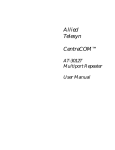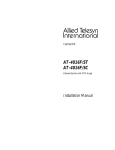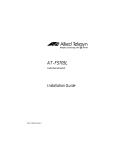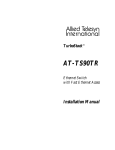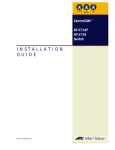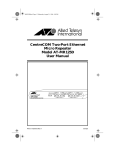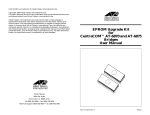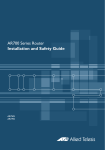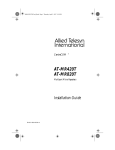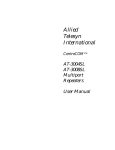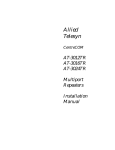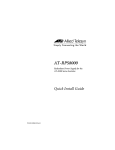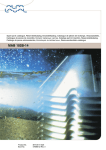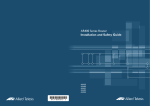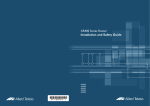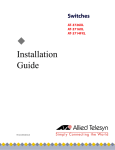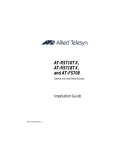Download Allied Telesyn User Manual
Transcript
Allied Telesyn CentreCOM™ AT-MR118FT AT-MR128FT Micro Repeaters User Manual Copyright 1994 Allied Telesyn International Corp. All rights reserved. No part of this publication may be reproduced without prior written permission from Allied Telesyn International Corp. Allied Telesyn International Corp. reserves the right to make changes in specifications and other information contained in this document without prior written notice. The information provided herein is subject to change without notice. In no event shall Allied Telesyn International Corp. be liable for any incidental, special, indirect, or consequential damages whatsoever, including but not limited to lost profits, arising out of or related to this manual or the information contained herein, even if Allied Telesyn International Corp. has been advised of, known, or should have known, the possibility of such damages. Trademarks: CentreCOM is a registered trademark of Allied Telesyn International Corp. Ethernet is a registered trademark of Xerox Corporation. UNIX is a registered trademark of UNIX System Laboratories. Novell and NetWare are registered trademarks of Novell, Inc. Microsoft and MS-DOS are registered trademarks and LAN Manager and Windows for Workgroups are trademarks of Microsoft Corporation. 3Com is a registered trademark of 3Com. PC-NFS is a trademark of Sun Microsystems, Inc. PC/TCP is a registered trademark of FTP Software, Inc. RADIATED ENERGY U.S. Federal Communications Note: This equipment has been tested and found to comply with the limits for a Class A digital device pursuant to Part 15 of FCC Rules. These limits are designed to provide reasonable protection against harmful interference when the equipment is operated in a commercial environment. This equipment generates, uses, and can radiate radio frequency and, if not installed and used in accordance with this instruction manual, may cause harmful interference to radio communications. Operation of this equipment in a residential area is likely to cause harmful interference in which case the user will be required to correct the interference at his own expense. Electrical Safety and Installation Requirements Note: Modifications or changes not expressly approved of by the manufacturer or the FCC, can void your right to operate this equipment. Canadian Department of Communications This digital apparatus does not exceed the Class A limits for radio noise emissions from digital apparatus as set out in the radio interference regulations of the Canadian Department of Communications. Le présent appariel numérique n' émet pas de bruits radioélectriques dépassant les limites appicables aux appariels numériques de Classe A. Prescrites dans le réglement sur le brouillage radioélectrique edicte par le minestére des Communications Du Canada. SAFETY WARNING: ELECTRICAL NOTICES ELECTRIC SHOCK HAZARD To prevent ELECTRIC shock, do not remove cover. No user-serviceable parts inside. This unit contains HAZARDOUS VOLTAGES and should only be opened by a trained and qualified technician. To avoid the possibility of ELECTRIC SHOCK disconnect electric power to the product before connecting or disconnecting the LAN cables. ! LIGHTNING DANGER DANGER: DO NOT WORK on equipment or CABLES during periods of LIGHTNING ACTIVITY. CAUTION: POWER CORD IS USED AS A DISCONNECTION DEVICE. TO DE-ENERGISE EQUIPMENT disconnect the power cord. INSTALLATION ELECTRICAL—AUTO VOLTAGE ADJUSTMENT This product will automatically adjust to any voltage between the ranges shown on the label. ELECTRICAL—TYPE CLASS 1 EQUIPMENT THIS EQUIPMENT MUST BE EARTHED. Power plug must be connected to a properly wired earth ground socket outlet. An improperly wired socket outlet could place hazardous voltages on accessible metal parts. ELECTRICAL—CORD NOTICE Use power cord, maximum 4.5 meters long, rated 6 amp minimum, 250V, made of HAR cordage molded IEC 320 connector on one end and on the other end a plug approved by the country of end use. CAUTION: Air vents must not be blocked and must have free access to the room ambient air for cooling. Operating temperature This product is designed for a maximum ambient temperature of 50° C. All Countries: Install product in accordance with local and National Electrical Codes. iii SICHERHEIT ACHTUNG: GEFÄHRLICHE SPANNUNG Das Gehäuse nicht öffnen. Das Gerät enthält keine vom Benutzer wartbaren Teile. Das Gerät steht unter Hochspannung und darf nur von qualifiziertem technischem Personal geöffnet werden. Vor Anschluß der LAN-Kabel, Gerät vom Netz trennen. ! GEFAHR DURCH BLITZSCHLAG GEFAHR: Keine Arbeiten am Gerät oder an den Kabeln während eines Gewitters ausführen VORSICHT:DAS NETZKABEL DIENT ZUM TRENNEN DER STROMVERSORGUNG. ZUR TRENNUNG VOM NETZ, KABEL AUS DER STECKDOSE ZIEHEN. INSTALLATION AUTOMATISCHE SPANNUNGSEINSTELLUNG Dieses Gerät stellt sich automatisch auf die auf dem Etikett aufgeführten Spannungswerte ein. KLASSE 1 GERÄTE DIESE GERÄTE MÜSSEN GEERDET SEIN. Der Netzstecker darf nur mit einer vorschriftsmäßig geerdeten Steckdose verbunden werden. Ein unvorschriftsmäßiger Anschluß kann das Metallgehäuse Teile unter gefährliche elektrische Spannungen setzen. NETZKABEL Das Netzkabel sollte eine maximale Länge von 4.5 Metern, einen Nennwert von mindestens 6 A und 250 V haben, aus HAR-Material hergestellt und mit einer gepreßten, IEC 320 entsprechenden, Anschlußverbindung an einem Ende, und am anderen Ende mit einem im Land des Endverbrauchers geprüften Stecker ausgestattet sein. VORSICHT: Die Entlüftungsöffnungen dürfen nicht versperrt sein und müssen zum Kühlen freien Zugang zur Raumluft haben. BETRIEBSTEMPERATUR Dieses Produkt wurde für den Betrieb in einer Umgebungstemperatur von nicht mehr als 50° C entworfen. Alle Länder: Installation muß örtlichen und nationalen elektrischen Vorschriften entsprechen. STRÅLINGSENERGI Dette kommercielle produkt opfylder de krav, der i USA stilles til udstyr af Klasse A. SIKKERHED ADVARSEL: ELEKTRISK FORH OLDSREGLER RISIKO FOR ELEKTRISK STØD RISIKO FOR ELEKTRISK STØD For at forebygge ELEKTRISK stød, undlad at åbne apparatet. Der er ingen indre dele, der kan repareres af brugeren. Denne enhed indeholder LIVSFARLIGE STRØMSPÆNDINGER og bør kun åbnes af en uddannet og kvalificeret tekniker. For at undgå risiko for ELEKTRISK STØD, afbrydes den elektriske strøm til produktet, før LAN-kablerne monteres eller afmonteres. FARE UNDER UVEJR FARE: UNDLAD at arbejde på udstyr eller KABLER i perioder med LYNAKTIVITET. ! ADVARSEL: DEN STRØMFØRENDE LEDNING BRUGES TIL AT AFBRYDE STRØMMEN. SKAL STRØMMEN TIL APPARATET AFBRYDES, tages ledningen ud af stikket. INSTALLATION ELEKTRISK—AUTOMATISK SPAENDINGSREGULERING Dette apparat vil automatisk tilpasse sig enhver spænding indenfor de værdier, der er angivet på etiketten. ELEKTRISK—KLASSE 1-UDSTYR DETTE UDSTYR KRAEVER JORDFORBINDELSE. Stikket skal være forbundet med en korrekt installeret jordforbunden stikkontakt. En ukorrekt installeret stikkontakt kan sætte livsfarlig spænding til tilgængelige metaldele. iv ELEKTRISK—LEDNING Anvend ledning af maksimum 4.5 meters længde, med en kapacitet på minimum 6 amp, 250 v, bestående af en IEC 320 connector med indstøbt HAR ledning i den ene ende og et stik i den anden ende godkendt der er af myndighederne i brugerlandet. ADVARSEL: Ventilationsåbninger må ikke blokeres og skal have fri adgang til den omgivende luft i rummet for afkøling. BETJENINGSTEMPERATUR Dette apparat er konstrueret til en omgivende temperatur på maksimum 50 grader C. ALLE LANDE: Installation af produktet skal ske i overensstemmelse med lokal og national lovgivning for elektriske installationer. STRALINGSENERGIE Dit handelsprodukt werd getest en voldoet aan de Amerikaanse vereisten voor een klasse A toestel. VEILIGHEID WAARSCHUWINGEN MET BETREKKING TOT ELEKTRICIT EIT WAARSCHUWING: GEVAAR VOOR ELEKTRISCHE SCHOKKEN Gelieve het deksel niet te verwijderen, teneinde ELEKTRISCHE schokken te voorkomen. Binnenin bevinden zich geen onderdelen die door de gebruiker kunnen worden onderhouden. Dit toestel staat onder GEVAARLIJKE SPANNING en mag alleen worden geopend door een daartoe opgeleide en bevoegde technicus. Om het gevaar op ELEKTRISCHE SCHOKKEN te vermijden, moet u het toestel van de stroombron ontkoppelen alvorens de LAN-kabels te koppelen of ontkoppelen. ! WAARSCHUWINGEN: GEVAAR VOOR BLIKSEMINSLAG GEVAAR: NIET aan toestellen of KABELS WERKEN bij BLIKSEM. WAARSCHUWING: HET TOESTEL WORDT UITGESCHAKELD DOOR DE STROOMKABEL TE ONTKOPPELEN. OM HET TOESTEL STROOMLOOS TE MAKEN: de stroomkabel ontkoppelen. INSTALLATIE AELEKTRISCH AUTOMATISCHE AANPASSING VAN DE SPANNINGL Dit toestel past zich automatisch aan elke spanning aan, tussen de waarden op het label vermeld. ELEKTRISCHE TOESTELLEN VAN KLASSE 1 DIT TOESTEL MOET GEAARD WORDEN. De stekker moet aangesloten zign op een juist geaarde contactdoos. Een onjuist geaarde contactdoos. Een onjuist geaarde contactdoos kan de metalen onderdelen onderdelen waarmee de gebruiker eventueel in aanraking komt onder gevaarlijke spanning stellen. ELEKTRISCHE—SNOEREN Gebruik een elektrisch snoer, maximum 4,5 meter lang, berekend voor ten minste 6 ampère, 250 V, uit HAR vervaardigd, met aan het ene uiteinde een gevormde IEC 320 stekker en aan het andere uiteinde een stekker die goedgekeurd is door het land waar het toestel zal worden gebruikt. WAARSCHUWINGEN: De ventilatiegaten mogen niet worden gesperd en moeten de omgevingslucht ongehinderd toelaten voor afkoeling. BEDRIJFSTEMPERATUUR De omgevingstemperatuur voor dit produkt mag niet meer bedragen dan 50 graden Celsius. ALLE LANDEN: het toestel installeren overeenkomstig de lokale en nationale elektrische voorschriften. v ENERGIE RAYONNEE Ce matériel a été testé et est certifié conforme par la réglementation américaine aux normes définies pour les appareils de classe A. SECURITE INFORMATION SUR L’ELECTRICITE AVERTISSEMENT: DANGER D’ELECTROCUTION Pour empêcher les dangers d’ELECTROCUTION, ne pas enlever le couvercle. L’équipement ne contient aucun élément réparable par l’utilisateur. Cet appareil comprend des TENSIONS DANGEREUSES et ne doit être ouvert que par un technicien dûment qualifié. Pour éviter tout risque d’ELECTROCUTION, débrancher l’appareil de la prise de courant avant de connecter ou de déconnecter les câbles LAN. ! DANGER DE FOUDRE DANGER: DANGER NE PAS MANIER l’équipement ou les CABLES pendant les périodes d’activité orageuse. ATTENTION: LE CORDON D’ALIMENTATION SERT DE MISE HORS CIRCUIT POUR COUPER L’ALIMENTATION DE L’APPAREIL, débranchez le cordon. INSTALLATION ELECTRICITE—REGLAGE DE TENSION AUTOMATIQUE Ce produit peut s’ajuster automatiquement sur n’importe quelle tension comprise dans la plage indiquée sur le label. ELECTRICITE—EQUIPEMENT DE CLASSE 1 CET APPAREIL DOIT ETRE MIS A LA TERRE. La prise de courant doit être branchée dans une prise femelle correctement mise à la terre. Sinon, des tensions dangereuses risqueraient d’atteindre les pièces métalliques accessibles à l’utilisateur. ELECTRICITE—INFORMATION SUR LE CORDON Utiliser un cordon secteur de 4,5 mètres de long maximum, calibré à 6 ampères minimum, 250V, et fabriqué en câblage HAR avec connecteur IEC 32C moulé à une extrémité et à l’autre extrémité, une prise de courant mâle répondant aux normes du pays d’utilisation. INSTRUCTIONS DE MONTAGE ATTENTION: Ces modèles sont destiné à functionner en position horizontale. L’appareil NE DOIT PAS être utilisé en MONTAGE VERTICAL sans employer un chassis de montage vertical. ATTENTION: Ne pas bloquer les fentes d’aération, ce qui empêcherait l’air ambiant de circuler librement pour le refroidissement. TEMPERATURE DE FONCTIONNEMENT Ce produit est capable de tolérer une température ambiante maximum de 50 degrés Celsius POUR TOUS PAYS: Installer le produit conformément aux normes électriques nationales et locales. SÄTEILYENERGIA Tämä kaupallinen tuote on testattu ja noudattaa Yhdysvaltojen vaatimuksia luokan A laitteelle. TURVALLISUUS SÄHKÖÖN LIITTYVIÄ HUOMAUTUKSIA VAROITUS: SÄHKÖISKUVAARA Estääksesi SÄHKÖISKUN älä poista kantta. Sisällä ei ole käyttäjän huollettavissa olevia osia. Tämä laite sisältää VAARALLISIA JÄNNITTEITÄ ja sen voi avata vain koulutettu ja pätevä teknikko. Välttääksesi SÄHKÖISKUN mahdollisuuden katkaise sähkövirta tuotteeseen ennen kuin liität tai irrotat paikallisverkon (LAN) kaapelit. SALAMANISKUVAARA HENGENVAARA: ÄLÄ TYÖSKENTELE laitteiden tai KAAPELEIDEN KANSSA SALAMOINNIN AIKANA. vi ! HUOMAUTUS: VIRTAJOHTOA KÄYTETÄÄN VIRRANKATKAISULAITTEENA. VIRTA KATKAISTAAN irrottamalla virtajohto. ASENNUS SÄHKÖ —AUTOMAATTINEN JÄNNITTEENSÄÄTÖ Tämä tuote säätää automaattisesti mihin tahansa jännitteeseen ohjetarrassa annettujen arvojen välillä. SÄHKÖ —TYYPPILUOKAN 1 LAITTEET TÄMÄ LAITE TÄYTYY MAADOITTAA. Pistoke täytyy liittää kunnollisesti maadoitettuun pistorasiaan. Virheellisesti johdotettu pistorasia voi altistaa metalliosat vaarallisille jännitteille. SÄHKÖ —JOHTOON LIITTYVÄ HUOMAUTUS Käytä seuraavanlaista virtajohtoa: maksimipituus 4,5 metriä, minimiteho 6 ampeeria, 250 V, valmistettu HAR-johdostosta, muovattu IEC 320 -liitin toisessa päässä ja käyttömaassa hyväksytty pistoke toisessa päässä. HUOMAUTUS: Ilmavaihtoreikiä ei pidä tukkia ja niillä täytyy olla vapaa yhteys ympäröivään huoneilmaan, jotta ilmanvaihto tapahtuisi. KÄYTTÖLÄMPÖTILA Tämä tuote on suunniteltu ympäröivän ilman maksimilämpötilalle 50° C. KAIKKI MAAT: Asenna tuote paikallisten ja kansallisten sähköturvallisuusmääräysten mukaisesti. ENERGIA IRRADIATA Questo prodotto commerciale è stato collaudato e risponde ai requisiti U.S.A. per i dispositivi di classe A. NORME DI SICUREZZA AVVERTENZE ELETTRICHE PERICOLO DI SCOSSE ELETTRICHE Per evitare SCOSSE ELETTRICHE non asportare il coperchio. Le componenti interne non sono riparabili dall’utente. Questa unità ha TENSIONI PERICOLOSE e va aperta solamente da un tecnico specializzato e qualificato. Per evitare ogni possibilità di SCOSSE ELETTRICHE, interrompere l’alimentazione del dispositivo prima di collegare o staccare i cavi LAN. ! PERICOLO DI FULM INI PERICOLO: NON LAVORARE sul dispositivo o sui CAVI durante PRECIPITAZIONI TEMPORALESCHE. ATTENZIONE: IL CAVO DI ALIMENTAZIONE È USATO COME DISPOSITIVO DI DISATTIVAZIONE. PER TOGLIERE LA CORRENTE AL DISPOSITIVO staccare il cavo di alimentazione. INSTALLAZIONE ELETTRICITÀ—REGOLAZIONE AUTOMATICA DELLA TENSIONE Questo prodotto regolerà automaticamente la tensione ad un valore compreso nella gamma indicata sull’etichetta. ELETTRICITÀ—DISPOSITIVI DI CLASSE 1 QUESTO DISPOSITIVO DEVE AVERE LA MESSA A TERRA. La spina deve essere inserita in una presa di corrente specificamente dotata di messa a terra. Una presa non cablata in maniera corretta rischia di scaricare una tensione pericolosa su parti metalliche accessibili. ELETTRICITÀ—AVVERTENZA SUL CAVO Usare un cavo della lunghezza massima di metri 4,5, con capacità minima di 6 A, 250 V, di filo HAR, dotato di connettore stampato IEC 320 ad un’estremità e di spina approvata dal paese di destinazione all’altra. ATTENZIONE: Le prese d’aria non vanno ostruite e devono consentire il libero ricircolo dell’aria ambiente per il raffreddamento. vii TEMPERATURA DI FUNZIONAMENTO Questo prodotto è concepito per una temperatura ambientale massima di 50 gradi centigradi. TUTTI I PAESI: installare il prodotto in conformità alle vigenti normative elettriche nazionali. UTSTRÅLT ENERGI Dette kommersielle produktet har blitt testet og er i samsvar med amerikanske krav for et A-Klasse apparat. SIKKERHET ELEKTRISKE MEDDELELSE ADVARSEL: FARE FOR ELEKTRISK SJOKK For å unngå ELEKTRISK sjokk, må dekslet ikke tas av. Det finnes ingen deler som du kan bruke på innsiden. Denne enheten inneholder FARLIGE SPENNING, og må kun åpnes av en opplært, kvalifisert tekniker. For å unngå muligheten av ELEKTRISK SJOKK, må den elektriske strømmen til produktet være av når du slår LAN-ledninger av og på. ! FARE FOR LYNANTENNELSE MÅ IKKE BRUKES på utstyr eller ledninger mens LYN-AKTIVITET er i gang. FORSIKTIG: STRØMLEDNINGEN BRUKES TIL Å SLÅ APPARATET AV. HVIS DU VIL DEAKTIVISERE UTSTYRET, må du fjerne strømledningen. INSTALLASJON ELEKTRISK—AUTO SPENNINGSTILPASSING Dette produktet vil automatisk bli tilpasset hvilken som helst strøminnstilling i de områdene som vises på etiketten. ELEKTRISKE—TYPE 1. KLASSE UTSTYR DETTE UTSTYRET MÅ JORDES. Strømkontakten må være tilkoplet en korrekt jordet grunnstøpselkontakt. En støpselkontakt som ikke er jordet på rett måte, kan tilføre farlig spenning til lett tilgjengelige metalldeler. ELEKTRISKE—MEDDELELSE OM LEDNINGER Bruk en strømledning av maksimal størrelse 4,5 m i lengde, vurdert for minst av 6 amp, 250V, fremstilt av HAR ledning IEC 320 koplingsstykke på den ene kanten og på den andre kanten en plugg som har blitt godkjent i det landet hvor den siste brukeren befinner seg. FORSIKTIG: Luftventilene må ikke blokkeres og må ha fri tilgang til luft med romtemperatur for avkjøling. DRIFTSTEMPERATUR Dette produktet har blitt fremstilt til bruk med maksimum romtemperatur på 50 grader celsius. ALLE LAND: Produktet må installeres i samsvar med de lokale og nasjonale elektriske koder. ENERGIA RADIADA Este produto foi testado e atende aos requisitos para dispositivos comerciais de Classe A nos E.U.A. SEGURANÇA AVISOS SOBRE CARACTERÍSTICAS ELÉTRICAS ATENÇÃO: PERIGO DE CHOQUE ELÉTRICO Para evitar CHOQUE ELÉTRICO, não retire a tampa. Não contém peças que possam ser consertadas pelo usuário. Este aparelho contém VOLTAGENS PERIGOSAS e só deve ser aberto por um técnico qualificado e treinado. Para evitar a possibilidade de CHOQUE ELÉTRICO, desconecte o aparelho da fonte de energia elétrica antes de conectar e desconectar os cabos da LAN. ! viii PERIGO DE CHOQUE CAUSADO POR RAIO PERIGO: NÃO TRABALHE no equipamento ou nos CABOS durante períodos suscetíveis de QUEDAS DE RAIO. CUIDADO: O CABO DE ALIMENTAÇÃO É UTILIZADO COMO UM DISPOSITIVO DE DESCONEXÃO.PARA DESELETRIFICAR O EQUIPAMENTO desconecte o cabo de alimentação. INSTALAÇÃO ELÉTRICO—AJUSTE AUTOMÁTICO DE VOLTAGEM Este produto ajustar-se-á automaticamente a qualquer voltagem que esteja dentro dos limites indicados no rótulo. ELÉTRICO—EQUIPAMENTOS DO TIPO CLASSE 1 DEVE SER FEITA LIGAÇÃO DE FIO TERRA PARA ESTE EQUIPAMENTO. O plugue deve ser conectado a uma tomada com ligação de fio terra. Tomadas sem ligação de fio terra podem transmitir voltagens perigosas a peças metálicas expostas. ELÉTRICO—AVISO SOBRE O CABO DE ALIMENTAÇÃO Use cabo de alimentação com comprimento máximo de 4,5 metros, com uma capacidade mínima de 6 amp e 250 V, fabricado de material para cabo HAR com conector moldado IEC 320 em uma extremidade e, na outra extremidade, um plugue aprovado para uso no país em questão . CUIDADO: As entradas de ar não devem ser bloqueadas e devem ter acesso livre ao ar ambiente para arrefecimento adequado do aparelho. TEMPERATURA DE FUNCIONAMENTO Este produto foi projetado para uma temperatura ambiente máxima de 50 graus centígrados. TODOS OS PAÍSES: Instale o produto de acordo com as normas federais e locais para instalações elétricas. ENERGIA RADIADA Este producto comercial ha sido probado y cumple con las normas requeridas en los EE. UU. para un dispositivo de Clase A. SEGURIDAD AVISOS ELECTRICOS ADVERTENCIA: PELIGRO DE ELECTROCHOQUE Para evitar un ELECTROCHOQUE, no quite la tapa. No hay ningún componente en el interior al cual puede prestar servicio el usuario. Esta unidad contiene VOLTAJES PELIGROSOS y sólo deberá abrirla un técnico entrenado y calificado. Para evitar la posibilidad de ELECTROCHOQUE desconecte la corriente eléctrica que llega al producto antes de conectar o desconectar los cables LAN. ! PELIGRO DE RAYOS PELIGRO: NO REALICE NINGUN TIPO DE TRABAJO O CONEXION en los equipos o en LOS CABLES durante TORMENTAS DE RAYOS ATENCION: EL CABLE DE ALIMENTACION SE USA COMO UN DISPOSITIVO DE DESCONEXION. PARA DESACTIVAR EL EQUIPO, desconecte el cable de alimentación. INSTALACION ELECTRICO—AUTO-AJUSTE DE TENSION Este producto se ajustará automáticamente a cualquier tensión entre los valores máximos y mínimos indicados en la etiqueta. ELECTRICO—EQUIPO DEL TIPO CLASE 1 ESTE EQUIPO TIENE QUE TENER CONEXION A TIERRA. El cable tiene que conectarse a un enchufe con tierra debidamente instalado. Un enchufe que no está correctamente instalado podría ocasionar tensiones peligrosas en las partes metálicas están expuestas. ELECTRICO—ADVERTENCIA SOBRE EL CABLE Use un cable eléctrico con un máximo de 4,5 metros de largo, con una capacidad mínima de 6 amperios, 250 V, hecho de cable HAR, con el conector moldeado IEC 320 en un extremo y con un enchufe que está aprobado por el país de uso final en el otro. ATENCION: Las aberturas para ventilación no deberán bloquearse y deberán tener acceso libre al aire ambiental de la sala para su enfriamiento. ix TEMPERATURA REQUERIDA PARA LA OPERACIÓN Este producto está diseñado para una temperatura ambiental máxima de 50 grados C. PARA TODOS LOS PAÍSES: Monte el producto de acuerdo con los Códigos Eléctricos locales y nacionales. ENERGIUTSTRÅLNING Denna handelsprodukt har testats och befunnits vara i enlighet med U.S.A.s krav för klass A utrustning. SÄKERHET TILLKÄNNAGIVANDEN BETRÄFFANDE ELEKTRICITETSRISK: RISK FÖR ELEKTRISK STÖT För att undvika ELEKTRISK stöt, ta ej av locket. Det finns inga delar inuti som behöver underhållas. Denna apparat är under HÖGSPÄNNING och får endast öppnas av en utbildad kvalificerad tekniker. För att undvika ELEKTRISK STÖT, koppla ifrån produktens strömanslutning innan LAN-kablarna ansluts eller kopplas ur. ! FARA FÖR BLIXTNEDSLAG FARA: ARBETA EJ på utrustningen eller kablarna vid ÅSKVÄDER. VARNING: NÄTKABELN ANVÄNDS SOM STRÖMBRYTARE FÖR ATT KOPPLA FRÅN STRÖMMEN, dra ur nätkabeln. INSTALLATION ELEKTRISKT—AUTOMATISK SPÄNNINGSJUSTERING Denna produkt justeras automatiskt till alla spänningar inom omfånget som indikeras på produktens märkning. ELEKTRISKT —TYP KLASS 1 UTRUSTNING DENNA UTRUSTNING MÅSTE VARA JORDAD. Nätkabeln måste vara ansluten till ett ordentligt jordat uttag. Ett felaktigt uttag kan göra att närliggande metalldelar utsätts för högspänning. Apparaten skall anslutas till jordat uttag, när den ansluts till ett nätverk. ELEKTRISKT —ANMÄRKNING BETRÄFFANDE KABELN Använd en kabel med maximum längd 4,5 meter och minimum 6 amp nominal, 250V, av HAR kabelfabrikat med ett specialutformat IEC 320-kontaktdon i ena änden och i den andra en plugg som godkänts i landet där produkten används. VARNING: Luftventilerna får ej blockeras och måste ha fri tillgång till omgivande rumsluft för avsvalning. DRIFTSTEMPERATUR Denna produkt är konstruerad för rumstemperatur ej överstigande 50 grader Celsius. ALLA LÄNDER: Installera produkten i enlighet med lokala och statliga bestämmelser för elektrisk utrustning x List of Figures List of Figures Figure 1: AT-MR118FT Front and Back Panels 8 Figure 2: AT-MR128FT Front and Back Panels 9 Figure 3: Typical Hub Configuration 11 Figure 4: 10BASE-T UTP Cabling Hub to MAU or NIC (Straight-Through) 19 Figure 5: 10BASE-T UTP Cabling Hub to Hub (Cross-Over) 19 Figure 6: Hub to MAU Wiring A.Usable and B. Unusable 21 Figure 7: Pin 1 Orientation on an RJ45 Connector 22 i List of Tables List of Tables Table 1: Table 2: Table 3: Table 4: The AT-MR118FT and AT-MR128FT Characteristics 1 CentreCOM Micro Repeater Dimensions 2 Usable and Unusable Twisted Pair Cable 18 MDI/MDI-X Switch Settings for Common Connection 20 i Table of Contents Electrical Safety and Installation Requirements ...................................... iii List of Figures ............................................................................................................. i List of Tables ............................................................................................................... i Chapter 1 Overview .......................................................................................................................1 CentreCOM Fiber Optic to 10BASE-T Micro Repeaters .........................................1 Dimensions of Internal and External Micro Repeaters.............................................2 Full- and Half-Repeater Modes .....................................................................................2 Connector Types ..............................................................................................................3 Power Requirements.......................................................................................................3 External Power Supply Micro Repeaters............................................................3 Internal Power Supply Micro Repeaters .............................................................3 Chapter 2 Cabling ...........................................................................................................................5 10BASE-T (UTP) Connections......................................................................................5 FOIRL or 10BASE-FL Fiber Optic Connections ......................................................6 Chapter 3 Operation ......................................................................................................................7 Switches ............................................................................................................................7 Indicators ..........................................................................................................................7 Setting Up Your Repeater .............................................................................................8 Chapter 4 Configuration ............................................................................................................11 Chapter 5 Troubleshooting .......................................................................................................13 Experiment with Possible Solutions...........................................................................13 17 Data Cabling Techniques .....................................................................................17 10BASE-T.......................................................................................................................17 UTP Port Wiring ...................................................................................................18 10BASE-FL/FOIRL Ethernet....................................................................................22 10BASE5 (Thick) Ethernet..........................................................................................22 AUI Drop Cables ...................................................................................................22 10BASE2 (Thin) Ethernet............................................................................................23 xi 25 Glossary ...................................................................................................................... 25 31 Technical Support Fax Order ........................................................................... 31 33 CentreCOM AT-MR118FT and AT-MR128FT Manual Feedback.......... 33 Index ............................................................................................................................. 35 List of Figures Figure 1: Figure 2: Figure 3: Figure 4: AT-MR118FT Front and Back Panels .............................................. 8 AT-MR128FT Front and Back Panels .............................................. 8 Typical Hub Configuration ............................................................. 11 10BASE-T UTP Cabling Hub to MAU or NIC (Straight-Through) ......................................................................... 19 Figure 5: 10BASE-T UTP Cabling Hub to Hub (Cross-Over) ...................... 19 Figure 6: Hub to MAU Wiring A. Usable and B. Unusable ......................... 21 Figure 7: Pin 1 Orientation on an RJ45 Connector ...................................... 22 List of Tables Table 1: Table 2: Table 3: Table 4: xii The AT-MR118FT and AT-MR128FT Characteristics ..................... 1 CentreCOM Micro Repeater Dimensions .......................................... 2 Usable and Unusable Twisted Pair Cable ...................................... 18 MDI/MDI-X Switch Settings for Common Connection ................... 20 Chapter 1 Overview CentreCOM Fiber Optic to 10BASE-T Micro Repeaters The AT-MR118FT and AT-MR128FT are fiber optic to Unshielded Twisted Pair (UTP) micro repeaters. The AT-MR118FT has an external power supply while the AT-MR128FT has an internal power supply. Both of these repeaters are two-port media converters designed for connections to a Fiber Optic (10BASE-FL) or Fiber Optic Inter-Repeater Link (FOIRL) segment and a UTP (10BASE-T) segment. Table 1 lists the product line. Table 1: The AT-MR118FT and AT-MR128FT Characteristics Model Power Supply Port 1 Port 2 AT-MR118FT-11/21 External UTP SMA Fiber Optic AT-MR118FT-13/23 External UTP ST Fiber Optic AT-MR128FT-11/21 Internal UTP SMA Fiber Optic AT-MR128FT-13/23 Internal UTP ST Fiber Optic Repeaters are used for two principal reasons. They are: ❑ ❑ To extend a signal beyond its normal length of transmission To complete a network connection in instances when one cannot be made Segments on either side of both repeaters support full length, fully repeated transmission. Only the fiber optic segment supports both full- and half-repeated transmission. Both segments allow the maximum number of nodes specified by the IEEE 802.3 specification. The repeaters are both compliant with both IEEE 802.3 and Ethernet standards. Both repeaters use state-of-the-art technologies, including a custom Application Specific Integrated Circuit (ASIC) and Surface Mount Technology (SMT), which provide enhanced functionality, increased reliability and improved performance. Network diagnostic LEDs are provided on the front of the micro repeaters to aid in troubleshooting and fault isolation. Both segments have On Line, Collision, Receive, Transmit and Link indicators. In addition, both repeaters have a central Power indicator. Refer to “Indicators” on page 7 for more information. 1 Overview Dimensions of Internal and External Micro Repeaters The primary difference between the AT-MR118FT and the AT-MR128FT repeaters is that the AT-MR128FT is a larger repeater because both the repeater and the power supply reside together in one chassis. The dimensions of the two repeaters are shown below in Table 2. Table 2: CentreCOM Micro Repeater Dimensions Model Dimensions AT-MR118FT 5.5 in. (140 mm) x 4.5 in. (114 mm) x 1.25 in. (32 mm) AT-MR128FT 8.5 in. (216 mm) x 4.5 in. (114 mm) x 1.25 in. (32 mm) The AT-MR118FT has a separate external power supply. Consequently, it is smaller, enabling you to connect to a hub or a Media Access Unit (MAU) when your physical environment does not allow space for a larger repeater. The CentreCOM Micro Repeaters are both relatively small in size and provide the complete functionality of larger repeaters that contain many ports, including packet regeneration and network partitioning. Full- and Half-Repeater Modes The AT-MR118FT and AT-MR128FT micro repeaters support both full- and half-repeater modes. You can select the appropriate mode required, using the full-repeater/half-repeater switch located next to the fiber optic ports. Full-repeater mode enables a simple retransmission of signals from the fiber optic port to the UTP port and vice versa, using the Packet Retiming Controller (PRC) to ensure bit integrity in signal packets. The packet regeneration results in a higher performance network by regenerating preamble, retiming the data packets and extending collision fragments to ensure collision enforcement by all nodes. Half-repeater mode aids in reducing the effective repeater count in networks capable of supporting half repeaters. This reduction is achieved by taking advantage of the lower distortion in the fiber optic media. The technique is used when a signal is sent from the fiber optic port to the UTP port, therefore, repeating occurs in only one direction. The half-repeater mode is used to reduce the number of repeaters a signal must traverse so that the four repeater rule restriction is not violated. For example, if you are using four repeaters, and two of them are set for half-repeater mode, the effective repeater count is three, enabling you to add another repeater without violating the four-repeater limit. If you want to realize the benefit of a repeater reduction, you have to remember to initiate half-repeating on two repeaters connected to each other. 2 CentreCOM™ Micro Repeaters Note The UTP-to-fiber optic port transmission needs to be regenerated by the PRC to ensure integrity of timing. Because the UTP-to-fiber optic transmission is routed through a regenerating chip, it uses the fullrepeater strategy and does not provide the repeater count reduction benefit associated with the half-repeater strategy. Connector Types Each repeater supports both fiber optic and UTP versions (RJ45 connection). The fiber optic repeater is available in either an SMA and ST version. The SMA screws into a threaded receptacle. The ST twists into a twist-lock receptacle. Power Requirements The power requirements of both the AT-MR118FT and the AT-MR128FT are described below. External Power Supply Micro Repeaters The AT-MR118FT has an external universal AC input/DC output power supply. Locate a 100-240 VAC, 50/60 Hz outlet and plug in the standard-equipment power cord. The power cord is only supplied in the U.S.A. version. Note Use only the AC power adapter. Using another manufacturer’s power adapter may permanently damage your micro repeater and void your warranty. Connect the power connector from the AC power adapter to the micro repeater. The Power indicator should illuminate. Internal Power Supply Micro Repeaters The AT-MR128FT has an internal universal AC input/DC output power supply. Locate the 100-120/200-240 VAC, 50/60 Hz power outlet and plug in the standardequipment power cord. The power cord is only supplied in the U.S.A. version. Insert the power plug into the micro repeater. The Power indicator should illuminate. 3 Chapter 2 Cabling Two types of cabling exist for the AT-MR118FT and AT-MR128FT. They are: ❑ ❑ UTP (10BASE-T) Fiber Optic (10BASE-FL/FOIRL) The 10BASE-T cabling type is UTP while 10BASE-FL and FOIRL is fiber optic with FL covering a greater distance than FOIRL. Both cabling types have IEEE 802.3 specifications and limits associated with them. They are described in the following sections. If you need detailed information on cabling, see Appendix A. For more information, read the IEEE 802.3 specification where cabling regulations are outlined. 10BASE-T (UTP) Connections The micro repeater’s UTP connections support a full 100 meters (328 ft.) of UTP cable per the 10BASE-T specification. This twisted pair segment connects directly to either a Data Terminal Equipment (DTE) or transceiver. The RJ45 connector may be plugged directly to the UTP port. The cable should be at least Level 3 UTP, 100 Ω impedance, 22 to 26 American Wire Gauge (AWG), a minimum of three twists per foot, and should not exceed 100 meters (328 ft.) in length. Note 10BASE-T UTP media was implemented to reduce Ethernet wiring costs. Much of the existing cabling is not suitable for Ethernet 10 Mb data rates. Care must be taken to ensure the UTP wiring used for 10BASE-T is able to carry these Ethernet data rates before a 10BASE-T network solution is implemented. Unlike the coaxial Ethernet, 10BASE2 and 10BASE5 architectures, the 10BASE-T UTP protocol is point-to-point wiring. For more detailed information on 10BASE-T, see Appendix A. 5 Cabling FOIRL or 10BASE-FL Fiber Optic Connections Warning Hazardous light emissions may exist in fiber optic systems. Severe eye damage may result if precautions are not taken. Never look into a transmitting fiber optic device, transceiver, repeater or cable. The IEEE 802.3 10BASE-FL port supports up to 2,000 meters (6,560 ft.) of multimode duplex fiber optic cable in a point-to-point link which directly attaches two devices. Duplex refers to support for fiber optic cable pairs, enabling a twocable fiber optic connection with transmit mode dedicated to one cable and receive mode on the other. 10BASE-FL supports connections of 2,000 meters (6,560 ft.) while FOIRL supports connections of 1,000 meters (3,280 ft.). FL is compatible with FOIRL, but restricts distance to 1 km. The wide dynamic range of the fiber optic interface on the AT-MR118FT and AT-MR128FT allows for an easy installation. Both the SMA and ST connections are industry-standard interfaces. Caution ! 6 Make sure the fiber optic cable connector is not forced into the ST receptacle. The ST connector is keyed. Gently rotate the connector plug until the key slips into the notch of the fiber optic receptacle. Chapter 3 Operation The AT-MR118FT and AT-MR128FT repeaters both retime and regenerate the Ethernet signal symmetry and regenerate the packet preamble. The micro repeaters also count the number of consecutive collisions. If this number reaches 32, then the repeater will take the segment Off Line (partition) to prevent a total network failure. This process is known as automatic segmentation. If one valid Ethernet packet is received on that segment, the repeater will place the segment On Line automatically, thus disconnecting problem segments and reconnecting valid segments. Switches The AT-MR118FT and AT-MR128FT repeaters each have two switches. They are: ❑ ❑ A full-repeater/half-repeater switch A straight-through/cross-over selection switch (MDI/MDI-X) The full-repeater/half-repeater selection switch is used to select the half- or fullrepeater functions. The straight-through/cross-over selection switch enables and disables the internal cross-over function. It indicates whether straight-through (MDI) or cross-over (MDI-X) connections are being enabled. Indicators The following diagnostic indicators are common to the micro repeaters. The AT-MR118FT and AT-MR128FT both have five indicators per port. In addition, there is a power LED for the entire repeater. Each indicator is described below. Power—Indicates the AC power adapter or power supply is providing power to the repeater. Collision—Indicates a collision detected on that port. On Line—Indicates when the port is ready for operation and is not partitioned. Receive—Indicates when a packet is received on that port. Brief flashes indicate low traffic levels. Transmit—Indicates when a packet is transmitted. 7 Operation Link—Indicates when a valid link is detected by the receiver. The fiber optic Link indicator must be illuminated at both ends of the segment for Ethernet data to flow. Figure 1 and Figure 2 show the indicators and ports for both the AT-MR118FT and AT-MR128FT micro repeaters. COLLISION RECEIVE ON LINE COLLISION TRANSMIT RECEIVE TRANSMIT ON LINE POWER LINK TM LINK PORT 1: 10BASE-T CentreCOM MR118FT PORT 2: 10BASE-FL/FOIRL IEEE 802.3 MICRO REPEATER PORT 1 PORT 2 CentreCOM RJ45 PIN-OUT HALF TX MDI FULL REPEATER MR118FT MDI X IEEE 802.3 MICRO REPEATER RX 10 BASE-T 10BASE-FL/FOIRL POWER Figure 1: AT-MR118FT Front and Back Panels COLLISION ON LINE CentreCOM RECEIVE COLLISION TRANSMIT TM POWER MR128FT PORT 2 LINK LINK PORT 1: 10BASE-T IEEE 802.3 MICRO REPEATER RECEIVE TRANSMIT ON LINE PORT 2: 10BASE-FL/FOIRL PORT 1 TM RJ45 PIN-OUT HALF TX MDI FULL REPEATER MDI X RX 10BASE-FL/FOIRL 10 BASE-T CentreCOM POWER MR128FT IEEE 802.3 MICRO REPEATER Figure 2: AT-MR128FT Front and Back Panels Setting Up Your Repeater Here is an example procedure that results in the configuration in Chapter 4. The sample configuration contains the following elements: ❑ ❑ ❑ ❑ 8 An Attachment Unit Interface (AUI)/UTP hub connected to a 10BASE5 network in the main building An AT-MR118FT repeater in the main building An AT-MR128FT in the remote building An AUI/UTP hub in the remote building CentreCOM™ Micro Repeaters To set up the sample configuration 1. Plug in the power cords to a power outlet for all devices. 2. Use either a cross-over or straight-through cable to connect your AUI/UTP hub to the AT-MR118FT UTP port. If you are using a cross-over cable, change the position of the straight-through /cross-over selection switch on the AT-MR118FT to Media Dependent Interface–cross-over (MDI-X) so that the hub-repeater connection can occur. 3. Use fiber optic cable to connect your AT-MR118FT fiber optic port in the main building to the AT-MR128FT fiber optic port in the remote building. When connecting fiber optic cable, the receiving pin (RD) is connected to the transmitting pin (TD) and vice versa. 4. If you want to reduce the effective repeater count on your network, set your full-repeater/half-repeater switch to HALF to initiate half-repeater mode. If you find the half-repeater mode creates throughput problems, change the position of the switch to FULL to initiate full-repeater mode. 5. Use either a cross-over or straight-through cable to connect your AT-MR128FT to the AUI/UTP hub UTP port. If you are using a cross-over cable, change the position of the straight-through /cross-over selection switch on the AT-MR128FT to MDI-X so that the repeater-hub connection can occur. When you perform a system check To make sure your AT-MR118FT and AT-MR128FT micro repeaters are operating properly, perform the following steps. 1. Apply the proper power connection. 2. Check that the Power indicator is illuminated. 3. Connect a 10BASE-T UTP cable from the other device to the RJ45 connector and check that the Link indicator illuminates. If it does not illuminate, change the MDI/MDI-X switch and see if the Link indicator illuminates. 4. Connect a fiber optic cable to the fiber optic connectors and check that the Link indicator illuminates. 5. Transmit data through the micro repeater and check that the Receive and Transmit indicators illuminate. 9 Chapter 4 Configuration The configuration in Figure 3 demonstrates how the AT-MR118FT and AT-MR128FT can be used to link two networks. In this scenario, two buildings are linked by fiber optic cabling and the signals are distributed by UTP. This technique takes advantage of the stronger fiber optic signal and the less expensive UTP signal technique. Note The figure assumes that the MDI-X switch has been activated on both the AT-MR118FT and AT-MR128FT repeaters, enabling a hub-to-hub connection. See Appendix A for more information. Figure 3: Typical Hub Configuration 11 Chapter 5 Troubleshooting Experiment with Possible Solutions This chapter provides the common factors to check for troubleshooting. The first rule of troubleshooting is to isolate the problem. As you experiment, only vary one factor at a time. Substitute known good equipment and see if the problem persists or is eliminated. As a preliminary check, perform the following steps 1. Do not overlook the obvious—make sure the cables and connectors are securely attached. 2. If there is no power indication, check the AC power adapter at the AC receptacle and ensure that there is AC power available. Also, ensure that the power plug at the micro repeater is properly seated. On the AT-MR118FT or AT-MR128FT, if there is still no power indication, replace the power adapter and test again. 3. If the link LED does not illuminate with UTP or fiber optic media, make sure the cabling is intact and connected to a functioning network port. 4. If the link LED illuminates on a 10BASE-T segment, but data transfer is slow, collision-prone or non-existent, verify that your UTP cable is Level 3, 4 or 5. Level 1 and 2 voice-quality cable will not work properly. If the cable is more or less round, you probably have data-grade cable. In this case, it would not cause transmission problems. If, however, the cable appears flat (as “Silver Satin” telephone-type cable), you probably have voice-grade cable which will cause transmission problems. If it looks like telephone cable, discard the cable and connect the repeaters, using data-grade cable. 5. Check that the pin-outs are correct. See the procedure for UTP port on page 14. 13 Troubleshooting On a fiber optic segment, if the Link indicator is not illuminated or data packet traffic is disrupted 1. Check that the fiber optic Link indicator is illuminated on both ends of the fiber optic link. 2. Be sure the receive fiber is connected to the remote transmit port and the transmit fiber is connected to the remote receive port. If in doubt, it does no harm to reverse the two fibers. Check if the Link indicator is illuminated. 3. Check that the fiber optic transmit and receive ports are functioning by installing the AT-MR118FT or AT-MR128FT in place of another fiber optic repeater that is known to work. Check if the Link indicator is illuminated. 4. Check the fiber optic cable itself by swapping a fiber optic repeater that is known to work for the AT-MR118FT or AT-MR128FT. Check if the Link indicator is illuminated. Note Do not attempt to use the fiber optic micro repeater as a light source with the following test. The light power varies with the duty cycle and packet rate. 5. Determine that the losses in the fiber optic cable transmit and receive fibers are within the flux budget of the micro repeater. This task requires a fiber optic power meter to measure the actual loss on the fiber optic link cable. To be within IEEE specifications the measurement must be at least -32.5 db. The fiber optic cable must be 50/125, 62.5/125 or 100/125 micron multimode fiber. The maximum cable length is 2,000 meters (6,560 ft.). On a 10BASE-T UTP port, if the Link indicator is not illuminated or data packet traffic is disrupted With 10BASE-T Ethernet, most problems are with the UTP wiring. 1. Check that the UTP cross-over switch is properly set. Note Changing the MDI/MDI-X switch or swapping cross-over to straightthrough cable or vice versa to determine which is correct will not cause any harm. For repeater-to-10BASE-T hub connections, use a cross-over cable or set the switch to the MDI position. For connecting a repeater to a 10BASE-T transceiver or Network Interface Card (NIC) use a straight-through cable or set the switch to the MDI-X position. 14 CentreCOM™ Micro Repeaters 2. Use only UTP cable designed for use in 10BASE-T applications. 10BASE-T wiring lengths should not exceed 100 meters (328 ft.). The wiring should be routed away from devices known to emit electromagnetic interference, such as fluorescent lights, power transformers and relay equipment. If you have throughput problems 1. Check to see if your full-repeater/half-repeater selection switch is set to the half-repeater mode. Half-repeater mode may generate a high number of Cyclic Redundancy Check (CRC) or alignment errors which can slow your network throughput. The source of these errors may be bit jitter, which is the fluctuation of data packets in respect to a standard clock cycle. 2. To correct throughput problems, try changing the full-repeater/ half-repeater switch setting from half-repeater mode to full-repeater mode. Note If by changing the switch setting to full-repeater mode, you find that you have exceeded the four-repeater limit, change the switch setting back to half-repeater mode. 3. If the data errors are reduced, you may need to reconfigure your network. 15 Appendix A Data Cabling Techniques The following sections detail cabling techniques and port specifications for IEEE 802.3 media. For comprehensive treatment of these topics, refer to the original IEEE specification. 10BASE-T A serious problem exists concerning identification of modular cable. There are various grades of voice-quality and data-quality cables available. These can appear to be similar externally, although their high-speed data transmission characteristics, are radically different. The identification problem is exaggerated by the fact that some suppliers have sold purportedly data-quality cables manufactured with voice-quality cabling. If any voice-quality cabling is used in a 10BASE-T network system, data movement is slow, collision-prone or non-existent. To confuse the issue, the Link indicator on the interface will usually indicate a valid link in such a case. For the foregoing reasons, it is absolutely vital that all cabling used with the 10BASE-T connections is of Level 3, 4 or 5. As a rule of thumb, if a cable type is flat, it is typically untwisted, and will cause problems. If a cable is more or less round in section, it will typically work. 17 Data Cabling Techniques The five common modular cable specifications and their applicability to 10BASE-T network use are shown in Table 3. Table 3: Usable and Unusable Twisted Pair Cable Cable Level Cable Description AC Character Specification Twist/ Foot 10BASE-T OK? 1 Unshielded Untwisted N/A CCITT None NO! 2 Individual UTP 100 Ω ± 30 Ω RS232 1BASE5 AT&T PDS None NO! 3 Typical Individual UTP 100 Ω ± 15 Ω T1, AT&T ISDN 10BASE-T IBM Type 3 3-5 YES 4 Enhanced Individual UTP 100 Ω ± 30 Ω EIA, TIA 10BASE-T NEMA 5-8 YES 5 Individual UTP 100 Ω ± 30 Ω EIA, TIA 10BASE-T 8-10 YES UTP Port Wiring The AT-MR118FT and AT-MR128FT both have a 10BASE-T UTP port with an industry-standard RJ45 receptacle. The straight-through/cross-over switch enables you to configure the port as either a (MDI or MDI-X). This switch enables you to use either a cross-over cable or a straight-through cable no matter which interface type (MDI or MDI-X) the device being connected to has. The standard connection when using a micro repeater is from a Data Communications Equipment (DCE) device, such as the repeater, to a DTE device, such as a workstation NIC. This configuration uses a straight-through cable (see Figure 4) with the switch in the MDI-X position. 18 CentreCOM™ Micro Repeaters UTP MAU RJ45 PIN UTP HUB RJ45 PIN TD + 1 1 TD + TD - 2 2 TD - RD + 3 3 RD + Not Used 4 4 Not Used Not Used 5 5 Not Used RD - 6 6 RD - Not Used 7 7 Not Used Not Used 8 8 Not Used Figure 4: 10BASE-T UTP Cabling Hub-to-MAU or NIC (Straight-Through) Some situations require a DCE-to-DCE connection, for example when hubs are cascaded. This can be accomplished with a standard cross-over cable, as illustrated in Figure 5. By setting the switch to MDI, you may use a straight-through cable, eliminating the need for making or obtaining a cross-over cable. UTP MAU RJ45 PIN UTP MAU RJ45 PIN TD + 1 1 TD + TD - 2 2 TD - RD + 3 3 RD + Not Used 4 4 Not Used Not Used 5 5 Not Used RD - 6 6 RD - Not Used 7 7 Not Used Not Used 8 8 Not Used Figure 5: 10BASE-T UTP Cabling Hub-to-Hub (Cross-Over) 19 Data Cabling Techniques Note The interface type that IEEE specifies as standard for a repeater such as the AT-MR1x8FT is MDI-X. The straight-through/cross-over switch merely provides convenience to avoid having to obtain an alternate cable in some applications. If you connect a cable and it does not work, try changing the MDI switch. The rule of thumb is the total number of cross-overs must be odd. You cannot harm the repeater by having the MDI switch in the wrong position. Table 4 shows which position the straight-through/cross-over selection switch needs to be for the device configuration shown. Table 4: MDI and MDI-X Switch Settings for Common Connection1 Model Connected to MDI MDI-X AT-MR118FT/AT-MR128FT Hub X AT-MR118FT/AT-MR128FT MAU X AT-MR118FT/AT-MR128FT NIC X AT-MR118FT/AT-MR128FT Transceiver X 1. This table assumes a straight-through cable is being used. The switch settings are the opposite of what is shown if a cross-over cable is being used. 20 CentreCOM™ Micro Repeaters In both the cross-over and straight-through instances, the wire is twisted pair. Figure 6 demonstrates usable and unusable cable configurations for the straightthrough wire pairing in the UTP environment. A 1 Pair twisted as per Level 3, 4 or 5 cable. RJ45 Pin 1 RJ45 Pin TD+ 1 1 TD+ TD- 2 2 TD- RD+ 3 3 RD+ Not Used 4 4 Not Used Not Used 5 5 Not Used RD- 6 6 RD- Not Used 7 7 Not Used Not Used 8 8 Not Used 1 B This cable will not work for 10BASE-T. Note that 3 and 6 are twisted, but are not a pair. RJ45 Pin RJ45 Pin TD+ 1 1 TD+ TD- 2 2 TD- RD+ 3 3 RD+ Not Used 4 4 Not Used Not Used 5 5 Not Used RD- 6 6 RD- Not Used 7 7 Not Used Not Used 8 8 Not Used Figure 6: Hub to MAU Wiring A. Usable and B. Unusable Diagram A is correct because the proper pairs are twisted together. Diagram B is incorrect because the wires for the receive pair, pins 3 and 6, are not twisted together. This could result in excessive common mode noise and an unacceptably high data error rate. If you pair pins incorrectly, for example as shown in Figure 6, Diagram B, your network may have a high data error rate. In a straight-through cable, the transmit pins, 1 and 2, are paired, as are the receive pins, 3 and 6. In a cross-over cable (not shown), pins 1 and 2, TD+ and TD-, are paired, as are pins 3 and 6, RD+ and RD-. When pins 1 and 2 are crossed over, they connect to pins 3 and 6 respectively, and pins 3 and 6, when crossed over, connect to pins 1 and 2 respectively. See Figure 7 for the location of pin 1 so you can count your pins correctly. 21 Data Cabling Techniques On an RJ45 connector, it is important to know where pin 1 is so you can count your pins correctly. Figure 7 shows the location of pin 1. Pin 1 Figure 7: Pin 1 Orientation on an RJ45 Connector 10BASE-FL/FOIRL Ethernet The IEEE 802.3 10BASE-FL standard supports up to 2,000 meters (6,560 ft.) of multimode duplex fiber optic cable in a point-to-point link which directly attaches two devices. Duplex refers to support for fiber optic cable pairs, enabling a twocable fiber optic connection with transmit mode dedicated to one cable and receive mode on the other. 10BASE-FL supports connections of 2,000 meters (6,560 ft.) while FOIRL supports connections of 1,000 meters (3,280 ft.). FL is compatible with FOIRL, but restricts distance to 1,000 meters (3,280 ft.). The wide dynamic range of the fiber optic interface on the AT-MR118FT and AT-MR128FT allows for an easy installation. When connecting fiber optic cable, the receiving pin (RD) is connected to the transmitting pin (TD) and vice versa. 10BASE5 (Thick) Ethernet When configuring 10BASE5 coax segments, IEEE 802.3 specifications allow 100 MAU attachments or less, spaced at multiples of 2.5 meters (8.2 ft.) measured accurately from the cable end (50 Ω terminator included). The 10BASE5 cable segment can not exceed 500 meters (1,640 ft.) in length. Worst case “end to end” propagation delay of a 10BASE5 coax segment is 2165 ns. Propagation delay of 10BASE5 Ethernet coax is calculated at 4.33 ns/meter. Both ends of the segment must be terminated with a 50 Ω termination with a power rating of 0.5 watts or greater. Earth grounding of the segment shield must take place at only one point on the cable. AUI Drop Cables AUI or Drop cables can be no longer than 50 meters (164 ft.) each. Attachments may be made only to the cable ends at the 15-pin D-shell connector. AUI cables may have a maximum 257 ns propagation delay, as used for computing the worst case propagation delay of a cable system. AUI cable propagation delay is approximately 5.13 ns/meter. This cable internally consists of four shielded twisted pair wires with an overall shield and drain wire; a 15-pin D-shell male connector at one end and a 15-pin D-shell female connector at the other end. Cable impedance is nominally 78 Ω. The AUI cable typically connects a transceiver attached to a coaxial segment to a DTE (workstation). 22 CentreCOM™ Micro Repeaters 10BASE2 (Thin) Ethernet When configuring thin coax segments, IEEE 802.3 specifications allow 29 or fewer MAUs per cable segment spaced at no less than 0.5 meter (1.64 ft.). The 10BASE2 cable length can not exceed 185 meters (607 ft.) per 10BASE2 cable segment. The worst case propagation delay for a 185 meters (607 ft.) thin Ethernet segment is 950.9 ns. The propagation delay for 10BASE2 Ethernet cable is 5.14 ns/meter. Both ends of the segment must be terminated with a 50 Ω termination with a power rating of 0.5 watts or greater. Earth grounding of the segment shield must take place at only one point on the cable. 23 Appendix B Glossary 10BASE2—Also called thinnet or CheaperNet, 10BASE2 is a 10 MHz, baseband, 185 meters (607 ft.) maximum coaxial segment. Cable impedance is 50 Ω. 10BASE5—Also called thick Ethernet, 10BASE5 is a 10 MHz, baseband, 500 meters (1,640 ft.) maximum coaxial segment. The cable is commonly referred to as yellow cable. Cable impedance is 50 Ω. Thick Ethernet cable is typically used as a trunk or backbone path of the network. 10BASE-FL—IEEE 802.3 Fiber Optic Ethernet. A fiber optic standard that allows up to 2,000 meters (6,560 ft.) of multimode duplex fiber optic cable in a pointto-point link. 10BASE-T—IEEE 802.3 UTP Ethernet. Using low cost Level 3 or better UTP wiring, 100 meters (328 ft.) of point-to-point link segments are possible. Uses RJ45 connectors and sometimes 50-pin AMP connectors to a patch panel. Runs at 10 MHz. 50-PIN TELCO (RJ21)—This connector is very common in 10BASE-T wiring. As opposed to the RJ45 connector, the 50-pin Telco connector concentrates up to 12 UTP connections onto one connection. This concentration of UTP ports is then broken out for connection to a punch-down block inside a building’s wiring closet. 50-pin Telco connections provide a very clean, uncluttered interface to the building’s wiring. ATTACHMENT UNIT INTERFACE (AUI)—This is the cable connection from a MAU (transceiver) to a DTE (typically a workstation) consisting of a 15 conductor twisted pair cable of 50 meters (164 ft.) maximum length. BASEBAND COAXIAL SYSTEM—A system whereby information is directly encoded and impressed on the coaxial transmission medium. At any point on the medium, only one information signal at a time can be present without disruption. BAYONET NUT COUPLE (BNC) CONNECTOR—A 10BASE2 thin coax connector with push-on BNC locking lug that quickly locks into place with a half twist. BIT RATE (BR)—This is the rate of data throughput on the medium in bits per second. Ethernet specifies 10 million bits per second. BRANCH CABLE—The AUI cable interconnecting the DTE and MAU system components also known as a Drop cable. 25 Glossary BIT TIME—The duration of one bit symbol (1/BR). Ethernet specifies a bit time of 100 ns. COAX SEGMENT—A segment of Ethernet cable that contains MAU. CARRIER SENSE MULTIPLE ACCESS with COLLISION DETECT (CSMA/CD)—This is the access method employed by IEEE 802.3 LAN transceivers, by which multiple stations compete for use of the transmission medium (coax cable) for data packet transmission, and provides for a level of error detection should that transmission be corrupted or impeded by contention for the transmission medium. CARRIER SENSE—In a LAN, an ongoing activity of a data station to detect whether another station is transmitting. COAXIAL CABLE—A two conductor (center conductor, shield system), concentric, constant impedance transmission line used as the trunk medium in the baseband system. COAXIAL CABLE SEGMENT—A length of coaxial cable sections and coaxial connectors, and terminated at each end in its characteristic impedance. COLLISION—An unwanted condition that results from concurrent transmissions on the physical medium. COLLISION PRESENCE—A signal provided by the PLS to the PMA sublayer (within the physical layer) to indicate that multiple stations are contending for access to the transmission medium. COMPATIBILITY INTERFACE—The MDI coaxial cable interface and the AUI branch cable interface, the two points at which hardware compatibility is defined to allow connection of independently designed and manufactured components to the baseband transmission system. CROSS-OVER—Wiring is used when connecting a 10BASE-T MAU to another 10BASE-T MAU or a 10BASE-T hub to another 10BASE-T hub. For example, one 10BASE-T MAU would have the TD pair on the same pins as another 10BASE-T MAU. If pins were wired straight, there would be two transmitters on one pair with no receiver. Therefore, the cross-over cable crosses the TD pair with the RD pair of UTP cable connecting the TD pins on one end to the RD pins at the other end. D-SUB CONNECTOR—The AUI cable uses 15-pin D-sub connectors. “D” refers to the shape of the connector shell. Also called miniature D, DB15, or DIX connectors. DATA COMMUNICATION EQUIPMENT (DCE)—In RS232 specification a unit, such as a modem, for connecting a DTE to other equipment. A repeater connected to a terminal or workstation for OMEGA LOCAL management use is wired as a DCE. DATA TERMINAL EQUIPMENT (DTE)—In RS232 specification a unit typically at the end of a segment. The DTE could be an Ethernet workstation, repeater, or bridge. 26 CentreCOM™ Micro Repeaters DEPARTMENT CONCENTRATOR—Hub which provides a large number of workstation connections. The term, department concentrator, refers to multiple repeaters housed in an AT-36C8 chassis. See Hub/Repeater, Repeater. DIX CONNECTOR—See D-Sub Connector FOIRL — A fiber optic standard that allows up to 1,000 meters (3,280 ft.) of multimode duplex fiber optic cable in a point-to-point link. HARMONICA ADAPTER—This adapter provides a simple way to convert the 50-pin Telco connection to RJ45 connections. HEARTBEAT—See SQE HUB to HUB WIRING—See Hub to MAU Wiring HUB to MAU WIRING—UTP cables for 10BASE-T hub-to-MAU or Network Interface Controller (NIC) cards are wired straight-through. An RJ45 receptacle at the hub would wire pin to pin to the RJ45 receptacle at the MAU. HUB/REPEATER—A hub is a central signal distributor. It is used in a wiring topology consisting of several point-to-point segments originating from a central point. The term hub is often used interchangeably with the term repeater. Multiport 10BASE-T, 10BASE2 and fiber optic (10BASE-FL, FOIRL) repeaters are considered hubs. See Repeater. HOUSE WIRING—House wiring is the existing wiring inside a building. This wiring generally originates from one or more wiring closets such as a telephone room. Some older buildings may have wiring unsuitable for 10 Megabit data rates. In these circumstances, it is recommended that the wiring is tested with a 10BASE-T signal/wire tester. IMPEDANCE—An electrical characteristic of a circuit dealing with the combination of the AC and DC resistance and the appearance of that resistance to attached circuits. JABBER LOCK-UP—The MAU’s ability to automatically inhibit the transmit data from reaching the medium if the transmit data time length exceeds 150 ms duration. This protects the medium from being overrun with data packets from a possibly defective device. JAM—This is a term used to describe the collision reinforcement signal output by the MAU onto the transmission medium if the transmit data time length exceeds 150 µs duration. This protects the medium from being overrun with data packets from a possibly defective device. JITTER—The fluctuation of the data packet in respect to a standard clock cycle. Jitter is undesirable and must be minimized. LINK SEGMENT—The link segment of coaxial cable is a segment which has no MAU devices but links two LAN devices together such as repeaters. 27 Glossary LINK TEST—In 10BASE-T Ethernet there is a link test function that validates the UTP link. This consists of a pulse transmitted from point A on one pair and validated at point B. Point B also transmits a pulse on the second pair to be validated by point A. These pulses occur during media idle states (in between packets). MANAGEMENT AGENT—Software that is used to view hub activity and set hub variables. MAU—See Medium Attachment Unit MAU to MAU, HUB to HUB WIRING—10BASE-T MAU to MAU or hub to hub wiring generally requires a cross-over cable located somewhere along the UTP cable run. This may commonly occur at the punch-down block or between the RJ45 wall receptacle and the workstation. MAU/TRANSCEIVER—An Ethernet transceiver is a MAU. A 10BASE-T MAU interfaces the UTP media to an AUI port on a workstation, repeater, bridge, or other Ethernet devices. MDI/MDI-X—See Medium Dependent Interface MEDIUM ATTACHMENT UNIT (MAU)—In a LAN, a device used in a data station to couple the DTE to the transmission medium. MEDIUM DEPENDENT INTERFACE (MDI)—The mechanical and electrical interface between the trunk cable medium and the MAU. MDI-X is another version of the interface that enables like devices to connect, using different pinouts, avoiding conflicts that occur when receiving and transmitting packets use the same pin-out. N-SERIES—A barrel shaped, threaded connector used on 10BASE5 (thick Ethernet) coaxial cable. PATCH PANEL—A 10BASE-T patch panel may be between a punch-down block and UTP workstation. The patch panel generally has a female RJ45 connector on the front for each workstation and a Telco (RJ21) connector on the back, which are wired to a punch-down block. This provides a convenient way for the installer or network manager to connect the hub 10BASE-T ports into the desired building locations. PHYSICAL MEDIUM ATTACHMENT (PMA)—The portion of the MAU that contains the functional circuitry. PHYSICAL SIGNALING (PLS)—That portion of the physical layer contained within the DTE that provides the logical and functional coupling between MAU and data link layers. POLARITY CORRECTION—Many 10BASE-T UTP ports have a Polarity Correction function. If the UTP wiring has RD- and RD+ inadvertently crossed, the polarity correction function will sample the signal and electrically swap the wires. If the TD- and TD+ wires are crossed, the correction would occur at the MAU on the other end of the UTP link. This occurs within a single pair and should not be confused with the cross-over cable. 28 CentreCOM™ Micro Repeaters PROPAGATION DELAY—The time it takes a signal to travel from the input of a system component to the output. Usually measured in nanoseconds. IEEE 802.3 has specific propagation delay maximums for computing propagation budgets when designing a LAN. Cable length plays a major role in propagation delay. [i.e, a 50 meters (164 ft.) AUI cable has a maximum allowable propagation delay of 257 ns.] The propagation delay of cable is dependent on length and velocity factor of the cable type. There are also propagation delays associated with electronics attached to the system. PUNCH-DOWN BLOCK—The punch-down block is the wiring panel where the house wiring from the building’s offices terminates. This is where many 10BASET hubs would be located. Wiring installers use a special punch-down tool to insert the UTP wire for data and voice applications. REPEATER—A device used to extend the length, topology, or interconnectivity of the physical medium beyond that imposed by a single segment, up to the maximum allowable end-to-end trunk transmission line length. Repeaters perform the basic actions of restoring signal amplitude, waveform and timing applied to normal data and collision signals. RJ45—This connector is a 10BASE-T standard for connecting UTP cabling. They are inexpensive and easy to install onto UTP cable. SIGNAL QUALITY ERROR (SQE)—Also referred to as Collision or Collision Presence. This occurs when two devices attempt to transmit at the same time which is an illegal condition. SQE TEST—Commonly referred to as Heartbeat, is a special 802.3 signal sent by the MAU to the DTE to test the collision detection function. Some DTE want SQE and others do not. Repeaters do not want SQE Test. STRAIGHT-THROUGH—A type of wiring connection where the pins of one connector connect to the same pins of another connector. For example, pin 1 of one connector connects to pin 1 of another connector. THICK ETHERNET—See 10BASE5 THIN ETHERNET—See 10BASE2 TRUNK CABLE—The trunk coaxial cable system. UNSHIELDED TWISTED PAIR (UTP)—A cable used in 10BASE-T wiring that consists of at least two twisted pairs of 22 to 26 AWG wire. The pairs should have at least 3 twists per foot and have an impedance of 100 Ω. Level 3 and Level 4 UTP cable generally fits these criteria. 29 Appendix C Technical Support Fax Order Name___________________________________________________________ Company ________________________________________________________ Address _________________________________________________________ City ____________________ State/Province ____________________________ Zip/Postal Code _______________ Country ____________________________ Phone ___________________________ Fax ____________________________ Incident Summary Model number of Allied Telesyn product I am using ______________________ Network software products I am using (e.g., network managers)____________ _______________________________________________________________ Brief summary of problem __________________________________________ _______________________________________________________________ _______________________________________________________________ Conditions (List the steps that led up to the problem.) ____________________ _______________________________________________________________ _______________________________________________________________ Detailed description (Please use separate sheet) Technical Support Fax Numbers: Asia Singapore, Taiwan, Thailand, Malaysia, Indonesia, Korea, Hong Kong, Philippines, China, India (+65)-383-2079 France France, Belgium, Luxembourg, Holland, Italy, Spain, Australia, New Zealand, Greece, Middle East, Africa, South America (+33)-1-69-28-37-49 Germany Germany, Switzerland, Austria, Eastern Europe (+49)-30-435-70-650 North America United States, Canada, Mexico (206)-481-3790 United Kingdom United Kingdom, Denmark, Norway, Sweden, Finland, Iceland (+44)-1-865-390-002 31 Appendix D CentreCOM AT-MR118FT and AT-MR128FT Manual Feedback Please tell us what additional information you would like to see discussed in the manual. If there are topics you would like information on that were not covered in the manual, please photocopy this page, answer the questions and fax or mail this form back to Allied Telesyn. The mailing address and fax number are at the bottom of the page. Your comments are valuable when we plan future revisions of the manual. I found the following the most valuable _______________________________ _______________________________________________________________ _______________________________________________________________ _______________________________________________________________ _______________________________________________________________ I would like the following more developed _____________________________ _______________________________________________________________ _______________________________________________________________ _______________________________________________________________ _______________________________________________________________ I would find the manual more useful if ________________________________ _______________________________________________________________ _______________________________________________________________ _______________________________________________________________ _______________________________________________________________ Please fax or mail your feedback. Fax to 1-206-481-3790. Or mail to: Allied Telesyn Technical Publications Department 19015 North Creek Parkway Suite 200 Bothell, WA 98011 USA 33 Index A adapters harmonica 27 Telco 50-pin/RJ45 27 American Wire Gauge (AWG) 5 Application Specific Integrated Circuit (ASIC) 1 Attachment Unit Interface (AUI) 8 AUI 9, 22, 25 AUI drop specification 22 automatic segmentation 7 B baseband coaxial system 25 bit rate 25 bit time 26 C cabling 1, 3, 6 10BASE2 23 10BASE5 8 10BASE-FL 5, 6 cross-over cable 9 fiber optic (10BASE-FL) 1 Fiber Optic Inter-Repeater Link (FOIRL) 1 FOIRL 5, 6 straight-through 9 UTP (10BASE-T) 5 UTP-to-fiber optic 3 carrier sense 26 coax segment 26 coaxial cable 26 coaxial cable segment 26 collision 26 collision presence 26 compatibility interface 26 compliance four repeater rule 2 IEEE 802.3 6 IEEE 802.3 specification 1, 5 connector types 1, 3, 6 RJ45 3, 5 connectors 50-pin AMP 25 50-pin Telco 25 BNC 25 DIX 27 D-sub 26 N-series 28 RJ45 25, 29 SMA 1, 3, 6 ST 1, 3, 6 cross-over UTP wiring 26, 28 CSMA/CD 26 D Data Terminal Equipment (DTE) 5 DCE 26 department concentrator 27 dimensions AT-MR118FT 2 AT-MR128FT 2 DTE 22, 26 35 Index E Ethernet 1, 5, 7, 22 F fiber optic 2, 5, 6, 9 duplex cable 6 H harmonica adapter 27 heartbeat 27 house wiring 27 hub 27 hub/repeater 27 I impedance 5, 27 indicators Collision 1 Link 1 On Line 1 Power 1, 3 Receive 1 Transmit 1 J jabber 27 jam 27 jitter 27 L link segment 27 link test 28 M management agent management agent 28 MAU 23, 28 MDI 7, 28 MDI-X 7, 9 Media Access Unit (MAU) 2 Media Dependent Interface (MDI) 9 Media Dependent Interface–crossover (MDI-X) 9 36 P Packet Retiming Controller (PRC) 2 patch panel 28 PLS 28 PMA 28 polarity correction 28 power requirements 3 external power supply 1, 2, 3 internal power supply 1, 3 PRC 3 propagation delay 29 punch-down block 29 R receiving receiving pin (RD) 9 repeater 27, 29 full-repeater/half-repeater switch 2 setting up 8 repeater, full full-repeater mode 2, 9 repeater, half half-repeater mode 2, 9 S SQE 27, 29 SQE Test 29 straight-through UTP wiring 27 Surface Mount Technology (SMT) 1 switches 9 cross-over 7, 9 full-repeater 7, 9 half-repeater 7, 9 straight-through 7, 9 T transmitting transmitting pin (TD) 9 Index U UTP 2, 3, 8, 9, 29 Unshielded Twisted Pair (UTP) 1 W wiring 1, 3, 5, 6, 8, 9, 23 10BASE2 25 10BASE5 25 10BASE-T 25 AUI drop, specification 22 branch cable 25 CheaperNet 25 cross-over UTP 26, 28 drop cable 25 fiber optic 1, 9 house wiring 27 hub to MAU UTP 27 MAU to MAU UTP 26, 28 patch panel 28 straight-through UTP 27 thick Ethernet 25, 29 thinnet 25, 29 trunk cable 29 UTP 25 37











































